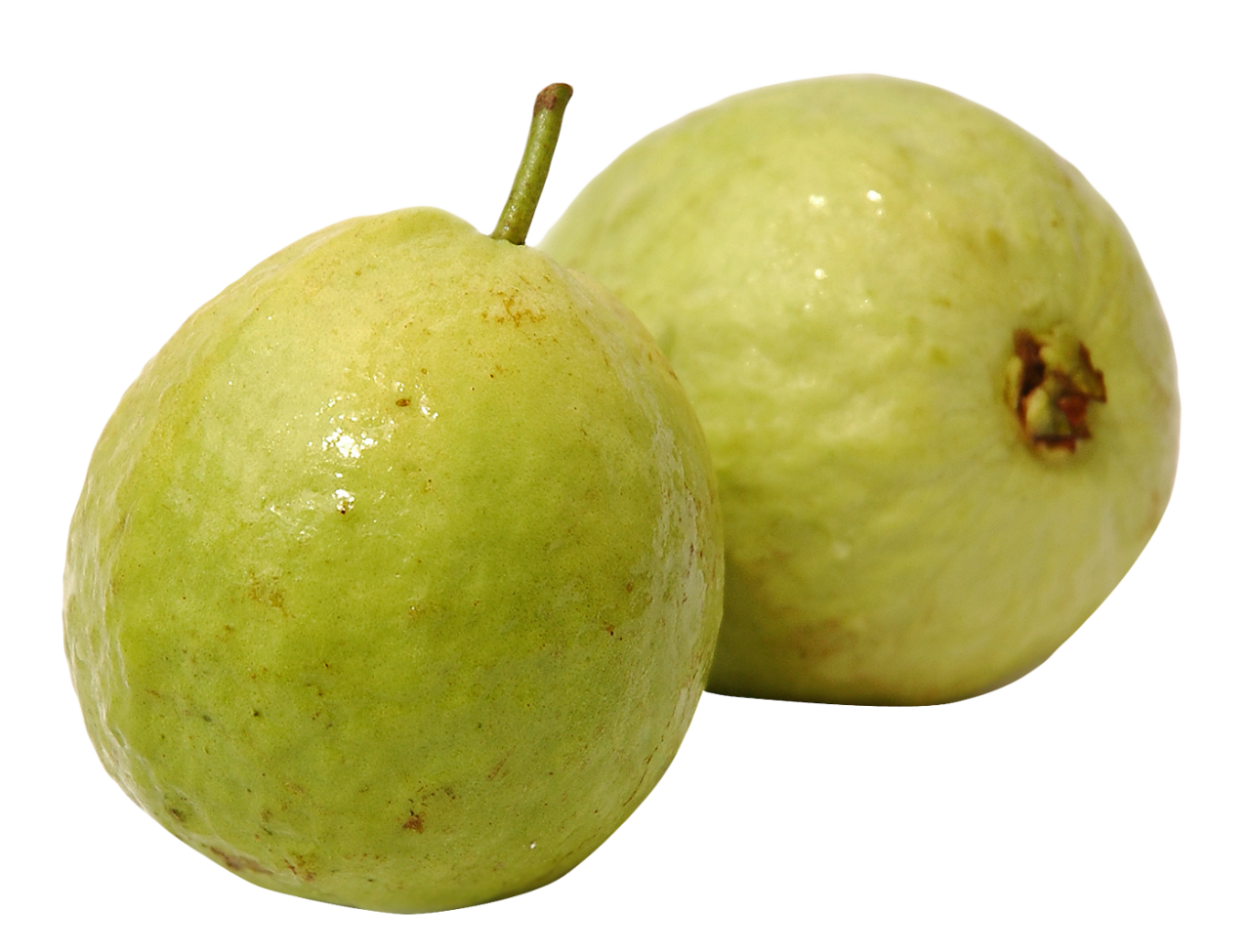
This image has format transparent PNG with resolution 1280x975.
You can download this image in best resolution from this page and use it for design and web design.
Guava PNG with transparent background you can download for free, just click on download button.
Guava is a common tropical fruit cultivated in many tropical and subtropical regions. Psidium guajava (common guava, lemon guava) is a small tree in the myrtle family (Myrtaceae), native to Mexico, Central America, and northern South America. Although related species may also be called guavas, they belong to other species or genera, such as the "pineapple guava" Acca sellowiana. In 2016, India was the largest producer of guavas with 41% of the world total.
The most frequently eaten species, and the one often simply referred to as "the guava", is the apple guava (Psidium guajava). Guavas are typical Myrtoideae, with tough dark leaves that are opposite, simple, elliptic to ovate and 5–15 centimetres (2.0–5.9 in) long. The flowers are white, with five petals and numerous stamens. The fruits are many-seeded berries.
The genera Accara and Acca (formerly Feijoa, pineapple guava) were formerly included in Psidium.
Guavas originated from an area thought to extend from Mexico or Central America and were distributed throughout tropical America and the Caribbean region. They were adopted as a crop in subtropical and tropical Asia, the southern United States (from Tennessee and North Carolina south, as well as the west and Hawaii), tropical Africa, South Asia, Southeast Asia, and Oceania. Guavas are now cultivated in many tropical and subtropical countries. Several species are grown commercially; apple guava and its cultivars are those most commonly traded internationally. Guavas also grow in southwestern Europe, specifically the Costa del Sol on Malaga, (Spain) and Greece where guavas have been commercially grown since the middle of the 20th century and they proliferate as cultivars.
Mature trees of most species are fairly cold-hardy and can survive temperatures slightly colder than 25 °F (4 °C) for short periods of time, but younger plants will likely freeze to the ground.
Guavas were introduced to Florida in the 19th century and are now grown in Florida as far north as Sarasota, Chipley, Waldo and Fort Pierce. However, they are a primary host of the Caribbean fruit fly and must be protected against infestation in areas of Florida where this pest is present.
Guavas are of interest to home growers in subtropical areas as one of the few tropical fruits that can grow to fruiting size in pots indoors. When grown from seed, guavas bear fruit as soon as two years and as long as 40 years.
Guava fruits, usually 4 to 12 centimetres (1.6 to 4.7 in) long, are round or oval depending on the species. They have a pronounced and typical fragrance, similar to lemon rind but less sharp. The outer skin may be rough, often with a bitter taste, or soft and sweet. Varying between species, the skin can be any thickness, is usually green before maturity, but may be yellow, maroon, or green when ripe. The pulp inside may be sweet or sour and off-white ("white" guavas) to deep pink ("red" guavas). The seeds in the central pulp vary in number and hardness, depending on species.
In Mexico and other Latin American countries, the guava-based beverage agua fresca is popular. The entire fruit is a key ingredient in punch, and the juice is often used in culinary sauces (hot or cold), ales, candies, dried snacks, fruit bars, and desserts, or dipped in chamoy. Pulque de guava is a popular alcoholic beverage in these regions.
In many countries, guava is eaten raw, typically cut into quarters or eaten like an apple, whereas in other countries it is eaten with a pinch of salt and pepper, cayenne powder or a mix of spices (masala). It is known as the winter national fruit of Pakistan. In the Philippines, ripe guava is used in cooking sinigang. Guava is a popular snack in Taiwan, sold on many street corners and night markets during hot weather, accompanied by packets of dried plum powder mixed with sugar and salt for dipping. In east Asia, guava is commonly eaten with sweet and sour dried plum powder mixtures. Guava juice is popular in many countries. The fruit is also often included in fruit salads.
Because of its high level of pectin, guavas are extensively used to make candies, preserves, jellies, jams, and marmalades (such as Brazilian goiabada and Colombian and Venezuelan bocadillo), and as a marmalade jam served on toast.
Red guavas can be used as the base of salted products such as sauces, substituting for tomatoes, especially to minimize acidity. A drink may be made from an infusion of guava fruits and leaves, which in Brazil is called che-de-goiabeira, i.e., "tea" of guava tree leaves, considered medicinal.
In this page you can download free PNG images: Guava PNG images free download